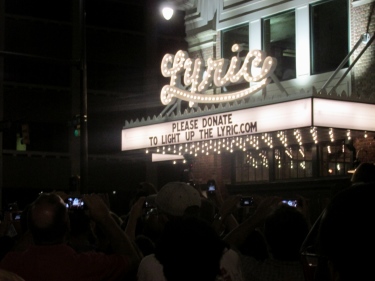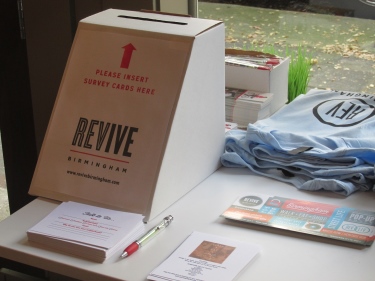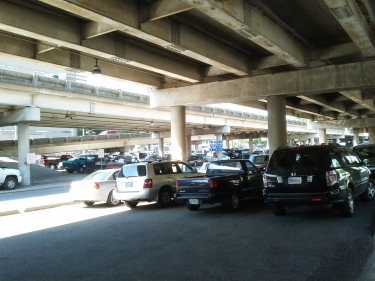 The term “game-changer” has been batted about metro Birmingham a lot in recent days as news of a planned mixed-use development anchored by a Publix grocery store on the city’s Southside spread like wild fire. For those who haven’t heard yet, an article in the May 18 edition of The Birmingham News revealed the Lakeland, FL-based grocer as the main tenant of a $30 million development proposed to sit on the northwest corner of 20th Street and 3rd Avenue South.
The term “game-changer” has been batted about metro Birmingham a lot in recent days as news of a planned mixed-use development anchored by a Publix grocery store on the city’s Southside spread like wild fire. For those who haven’t heard yet, an article in the May 18 edition of The Birmingham News revealed the Lakeland, FL-based grocer as the main tenant of a $30 million development proposed to sit on the northwest corner of 20th Street and 3rd Avenue South.
Now, I’ve lived in the greater downtown area since 2004, and I’ve always had as few as four and as many as six major options available to choose from within 2 miles, but I had to drive to them. When people ask me “Where and how do you get groceries?” I admit I’ve long ago started replying by asking them, “Well, where and how do you get yours?” I get a stunned look, but most times they seem to get what I’m saying. That said, it’s not an option readily or easily available to a significant number of our city’s residents.
This leads to my first reason why it’s a game-changer:
It’s more about WALKING now than DRIVING. Yes, there’s a parking deck that will sit between the ground floor space and the 36 “loft-style” apartments planned for the top the building. The vehicles using these spaces though will be off-street and out of sight. The idea of needing to circle forever to find a spot or the installation of a surface parking lot to handle capacity doesn’t even come up in conversation – and that’s a great thing. It suggests developers realize there will be enough people within walking distance to support its operation. It takes away reliance on an automobile to make a development like this one work.
It means it should be easier to get other national and regional retailers to consider locating a business downtown. It also makes it easier to get those same retailers to start looking at options in neighborhoods throughout the city. It could potentially make the issue of placing parking immediately adjacent to their business less of a sticking point. Dare it be suggested it could also be the first step toward a re-write of the city’s parking regulations and a rethinking of its minimum requirements?
It’s downtown. Actually, this may be an even bigger issue for me and one I’m excited about watching evolve. The proposed building is sitting along 20th Street South. When I first moved here nearly ten years ago, I referred to that area as being downtown while having a conversation with a native; I was chastised immediately because “it was not downtown, it was Southside. Downtown starts on the other side of the tracks.”
It was weird, as most New Yorkers refer to pretty much all of Manhattan as “downtown” no matter which of the other four boroughs you live. I’d also moved here after working for an agency charged with the revitalization of “greater Downtown” Savannah, not just its famous historic district. As a result, I’ve long considered the areas surrounding the city center part of greater downtown Birmingham. It makes sense especially when you get a chance to see just how small the expanded area still is in relation to the rest of the city.
The announcement of this grocery store lends itself to a new approach involving population growth in the urban core focused on eventually seeing people choosing to live in the single-family home dense portions of Druid Hills, Fountain Heights, and Norwood (in addition to others like Titusville, Smithfield, and College Hills) after spending a couple of years living in an apartment located nearby in the city center. Every major news outlet in the city referred to the project’s location area as downtown, suggesting the shift in perspective (one long championed by REV Birmingham and its predecessors) is finally starting to happen. The change in perspective also means a realization about the choices available to someone thinking about their next move.
The changes that come as a result of this and other projects will be quick. The changes at face value will be good for the city. The question right now as we get ready to start watching this happen is “Are we ready for what we’ve been asking for all of these years?”
André Natta is the stationmaster for bhamterminal.com.





 There’s been a great deal of conversation about the proposed lease agreement that would see the City of Birmingham occupy more than 263,000 square feet of space in
There’s been a great deal of conversation about the proposed lease agreement that would see the City of Birmingham occupy more than 263,000 square feet of space in  Friday night in Birmingham’s theater district was the kind of event more people will claim to have attended than were actually there in the coming years. Considering there were at least 1,000 people gathered in Birmingham’s theater district to watch
Friday night in Birmingham’s theater district was the kind of event more people will claim to have attended than were actually there in the coming years. Considering there were at least 1,000 people gathered in Birmingham’s theater district to watch 
 Yesterday I decided to point to a specific city that’s actually tackled an inner-city interstate replacement and
Yesterday I decided to point to a specific city that’s actually tackled an inner-city interstate replacement and  Yes, there’s recently been a significant amount of focus on proposed plans for I-20/59. Diehards have been aware of the topic since
Yes, there’s recently been a significant amount of focus on proposed plans for I-20/59. Diehards have been aware of the topic since 

Still dreaming big dreams for Birmingham in 2021
UPDATE: Birmingham was awarded the 2021 World Games on January 22, 2015.
I smirked as I said this during a chance encounter with David Brewer, executive director of the Friends of Rickwood Field, as we stood looking out at home plate in America’s oldest ballpark late Monday morning.
He laughed and said, “You know, you’re right,” as he returned to the never ending list of to-dos associated with his job, leaving me to think. I often find myself there in the historic structure on the city’s west side sitting in the general admission seats (or the first base dugout) in order to escape and think. This time, I tried to calm my mind to tackle some brainstorming but ended up dreaming big dreams. (It’s a bad habit of mine.) I thought of what it would be like to sit in the stands at Rickwood Field and Regions Field surrounded by others from around the world in 2021. It would take the International Baseball Federation successfully campaigning the International World Games Association to be added as a sport or a request of the city’s organizing committee, but there’s a chance…
That said, this current proposal is a little easier to swallow for folks and easier to celebrate if successful (especially since it would be during Birmingham’s 150th birthday, but I digress). While the World Games started as a way to focus more on the athletes and less on keeping score among nations, they have come to be as significant in meaning to the host city as a successful Olympic bid without nearly the same level of expense.
Why? Here it is, courtesy of the bid packet:
This means that while the multi-purpose facility (a.k.a. the Dome) is probably going to happen, it’s not affecting this bid one way or the other. That can be also read as it doesn’t necessarily mean facilities can’t be renovated or modernized in order to accommodate events. This suddenly makes things like seeing a City Council agenda item for a feasibility study of Legion Field earlier this year more understandable (especially when coupled with the mayor’s comments during this year’s State of the City address).
This is a city that needs an excuse to light a fire under itself to get something accomplished. It also needs reassurances from outsiders. This would seem to accomplish both while, as said elsewhere previously, leaving the city in a better place if the bid proves unsuccessful.
The DNC bid was due last Friday, June 6 (and some have already written about its potential for success, including this piece on June 9 by Cliff Sims at Yellowhammer News and this one published on June 8 by Chuck Dean of al.com/Alabama Media Group). The World Games bid is due on July 31. Once it’s arrived in Colorado, the hard part begins. We have to keep dreaming big dreams and acting on them.
After watching this recap video from the 2013 World Games in Cali, Colombia (or photos like this one from its closing ceremonies), I’m thinking it shouldn’t be too hard to do.
BTW – it should be noted that American football was chosen as one of the invitational sports for the 2017 World Games in Wroclaw, Poland. Just saying…
André Natta is the stationmaster for bhamterminal.com.
Leave a comment
Posted in Commentary, development
Tagged AL, bid, Birmingham, chances, opinion, World Games